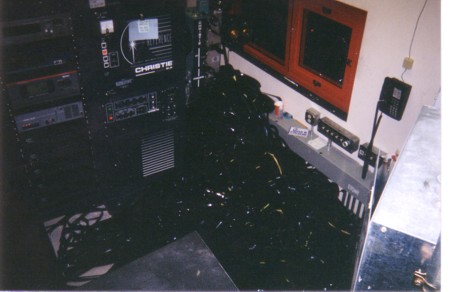|
|
This topic comprises 2 pages: 1 2
|
|
Author
|
Topic: What would you do if your print flew off?
|
|
|
|
|
|
|
|
|
|
|
Brad Miller
Administrator

Posts: 17775
From: Plano, TX (36.2 miles NW of Rockwall)
Registered: May 99
|
 posted 08-06-2007 02:55 PM
posted 08-06-2007 02:55 PM




Don't throw the print in the trash or the studio will try to have you murdered for "piracy" or some such nonsense.
Generally if a print gets tossed there are large chunks of it that are still in "loop" form. I had this happen (one peg on the center ring broke) on Titanic, and I got it back together making only 5 splices. Here is how to do it.
First, DON'T TOUCH OR MOVE THE PILE OF FILM!!!
Ok now that we have made that clear, it's time to pick up the first (easiest) loop of film that you can. You want to try and keep the sections in as large of a piece as possible without any tangling. Cut the film 2 perforations off of a camera cut frameline. (Yes, right dead center of the image, 1/2 of a frame to either side of where the camera changes angles. You can use a pair of scissors.) Set the loop of film onto an empty platter, thread the middle of it through the brain and route the rollers onto the MUT so that the MUT is breaking down "through" the brain. Let this loop of film wind onto the reel, making sure you DO NOT LEAVE IT! As the film accumulates onto the reel, it will pull the film through the brain faster and faster. As such you will end up with a brain wrap if you leave it for more than maybe a minute, so expect to have to slow your MUT down every minute or so during this process.
Now that you have the first chunk of film onto a reel (this may be 5 minutes worth of 3 reels worth), it's time to repeat that process again and again until you get it all onto reels.
At this point all of the reels SHOULD be "tails up"...but not necessarily. Regardless start with the last reel, which should be obvious to you. Wind it over to a 6000' reel, remembering that you just wound them THROUGH the brain, so the film rolls will not be wound tightly. In order to prevent further damage, you need to almost fully back off on your supply drag clutch on the rewind table.
When you get that last chunk of film onto the 6000 foot reel, look at the tip of it. You will either see a series of frames, with the first one cut in half...or you will see a series of frames, and then 2 perforations of a different frame. Regardless, just match it up to the next reel so you have a matching frame when the two ends are butted up against each other. Once you have found the next reel, cut the 2 perforations out and make a proper splice. Wind that reel and continue on and on until you get the entire movie back onto two or three 6000 foot reels, then reload to the platter.
Don't forget to run a film cleaner on the very next show!!! In fact you should plan on running the film cleaner on the next several shows at least to clean up the dust you picked up.
If you follow this routine and your booth is carpeted, you can expect for the print to essentially still be in near-perfect viewable condition. If you have a tile or cement floor, well you're just screwed, but at least this will help you get it back together in the most efficient way possible.
(FYI - if you were planning on shipping this print out, you still need to run it at least once and make sure you have it all put back together properly, which it should be. Then break it back down normally.)
| IP: Logged
|
|
|
|
|
|
|
|
|
|
|
|
|
|
Christopher Meredith
Expert Film Handler
Posts: 126
From: Jackson, MS, USA
Registered: Apr 2006
|
 posted 08-06-2007 07:32 PM
posted 08-06-2007 07:32 PM





I developed a technique for this once, by necessity. One of my trainees, after having been explicitly told not to try to move a print by himself, decided that moving a print from one platter deck to another was an acceptable exception. He was wrong and ended up dumping "Superman Returns" from the top platter right onto the floor.
What I ended up doing was taking a fistful of cable ties and set to work. I gathered up the largest sections possible without disturbing the "nest" and tied them off, one by one. Once I had separated it out as best I could. I cut the sections apart from one another until I had 7 or 8 large sections and several hundred (manageable) feet of twisted mess leftover. I then got the shipping reels out of the can and put one on the spindle of the rewind bench and threaded the inside of one of the large loops onto it. Then I laid the whole loop on the core of the reel, cut the cable tie, and started the motor, slowly. The flanges of the reel kept the section together and it eventually wound itself back onto the reel. I repeated the process until I had all the film wound up onto reels. Then it was just a matter of rebuilding the print back onto the platter, being careful to re-attach the sections at the right places.
Doing this, I was able to re-assemble the print, run it through the film cleaner, and break it down properly by myself, in one shift, while still running the projection booth as normal.
(This was a far cry better than when I had to help clean up "Prisoner of Azkaban" and it took three of us until sunup the next day to get it all back in the can!)
| IP: Logged
|
|
Monte L Fullmer
Film God

Posts: 8367
From: Nampa, Idaho, USA
Registered: Nov 2004
|
 posted 08-06-2007 11:44 PM
posted 08-06-2007 11:44 PM




Course, you can have this booth dilemma when a splice decides to hang up in the failsafe and all 5 reels pile up under the machine..

But, it was an easy cleanup as mentioned: grab the tail end and just wind the mess back up on reels on the MUT and not touching any of the film since it was laying down on top of another, then rebuild back on the platter - sending the completed build through a few passes through the Kelmar and FG and you're good to go as if it didn't happen.
Luckilly, this mess happened during the last show of the night, thus that closing operator had the privilege to do the procedures as mentioned above, thus no showings were lost.
Oh, I've had the dubious honour to clean up a print that flew off the deck on breakdown when the ring decides to undone itself from the deck and 6 reels went 'frisbee style' on the floor since the brain wasn't in the middle of that breakdown deck.
I'd just simply broke each splice to where I pulled out each reel from the "nest" and laid them aside. Then, just took each reel, put it on the deck, put a ring in the middle to help contain the that mess, spun the deck to match up with the rewind reel on the MUT and had all of that mess done within two hours with this procedure.
TONS, TONS of Fun! ![[Big Grin]](biggrin.gif)
| IP: Logged
|
|
|
|
|
|
All times are Central (GMT -6:00)
|
This topic comprises 2 pages: 1 2
|
Powered by Infopop Corporation
UBB.classicTM
6.3.1.2
The Film-Tech Forums are designed for various members related to the cinema industry to express their opinions, viewpoints and testimonials on various products, services and events based upon speculation, personal knowledge and factual information through use, therefore all views represented here allow no liability upon the publishers of this web site and the owners of said views assume no liability for any ill will resulting from these postings. The posts made here are for educational as well as entertainment purposes and as such anyone viewing this portion of the website must accept these views as statements of the author of that opinion
and agrees to release the authors from any and all liability.
|

 Home
Home
 Products
Products
 Store
Store
 Forum
Forum
 Warehouse
Warehouse
 Contact Us
Contact Us




 Printer-friendly view of this topic
Printer-friendly view of this topic






![[Smile]](smile.gif)




![[thumbsup]](graemlins/thumbsup.gif)



![[Big Grin]](biggrin.gif)




